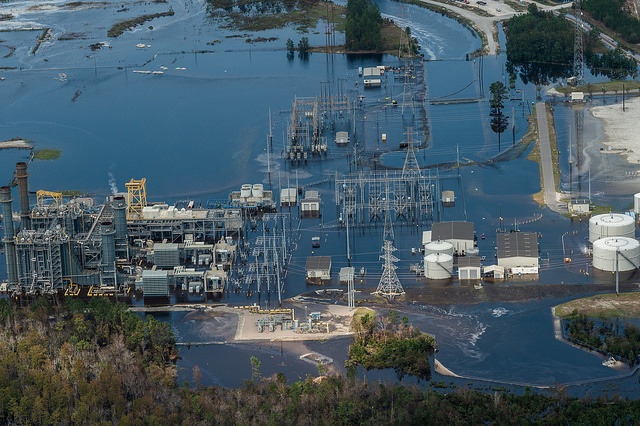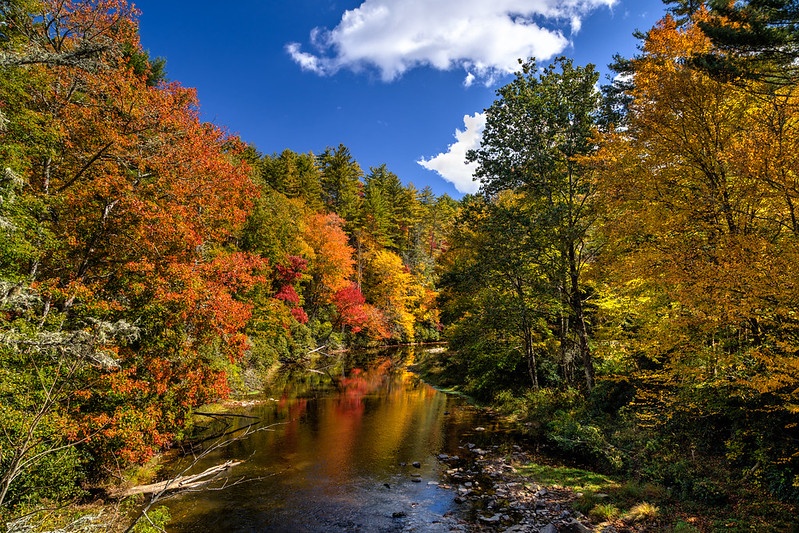We have much more to do and your continued support is needed now more than ever.
7 Ways Congress Could Help Safeguard Communities and Wildlife From Hurricanes

This year is already bringing an unusually active hurricane season, with more than a dozen named storms, including five hurricanes, halfway through the season. NOAA is predicting we may see as many as 25 named storms, over double the long-term average. Just last week Hurricane Laura took 10 lives and caused damage expected to total between $4 and $12 billion, according to NPR.
The hurricanes of recent years—Dorian, Michael, Florence, Harvey, María, Irma, and now Laura—have made it clear that the combination of extreme storms and intense development in coastal areas has left people, properties, and wildlife habitats at risk. And, climate change is contributing to more severe natural disasters including hurricanes, as seen in the National Wildlife Federation’s interactive Unnatural Disasters Story Map. Many of the necessary changes for hurricane preparation happen at the local or regional level, such as improved zoning and building codes. But there is much the federal government can do as well to keep us safer.

Below are seven ways Congress could take action to better protect our communities from hurricanes and other extreme storms:
Protect & Create Natural Infrastructure

Protecting and restoring natural areas—particularly wetlands and marshes that can absorb flood waters—is one of the most effective ways to prevent damage during extreme storms. Science shows that these solutions are successful and cost-effective when it comes to reducing risks from natural hazards, as demonstrated in the recent National Wildlife Federation and Allied World report, The Protective Value of Nature. For example, wetlands prevented $625 million in flood damages during Hurricane Sandy in the 12 affected coastal states. Wetlands, marshes and oyster reefs often provide valuable wildlife habitat, such as providing nursery grounds for juvenile fish.
Given these benefits, federal agencies should do more to expand the use of natural infrastructure in federal flood mitigation or coastal protection efforts. For example, the Army Corps should strive to incorporate natural infrastructure solutions for flood risk reduction wherever practicable. Agencies like FEMA should also work to ensure that natural infrastructure solutions are eligible and competitive for hazard mitigation program grants, and encourage states to explore such measures when updating hazard mitigation plans.
Infrastructure, as well as recovery and stimulus legislation designed to respond to the COVID-19 public health and economic crisis, are appropriate venues to invest in natural infrastructure. Such investments not only provide valuable risk mitigation and wildlife habitat — they also create quality jobs across the country that cannot be outsourced. For more information on economic and job opportunities from natural infrastructure, please visit our fact sheet.
Reform the National Flood Insurance Program

The National Flood Insurance Program (NFIP) is supposed to discourage development in high flood risk areas. But in reality, decades of discounted flood insurance rates have resulted essentially in a federal subsidy for homeowners in areas at risk of flooding—creating a perverse incentive to build in places likely to flood. The NFIP particularly needs to address the homes that make repeated claims over the years. According to the Wall Street Journal, just 2 percent of properties insured by the NFIP have accounted for about 30 percent of claims paid over the program’s history. Perhaps it is unsurprising that the program had a deficit of approximately $25 billion even before the 2017 and 2018 hurricane seasons.
After fifteen short-term extensions of the program as of September 1, 2020, Congress should fully reauthorize and reform the NFIP. Congress should also encourage increase pre-disaster hazard mitigation efforts, especially the use of natural infrastructure, and require and fund FEMA to update and increase the resolution of flood maps. Finally, Congress should continue gradually transitioning properties to risk-based rates, while providing for mitigation assistance and affordability measures for those who are low-income.
“Pre-spond” Instead of Respond

Increased national investment in hazard mitigation activities through FEMA and other agencies would help reduce the harm—and the payouts—from future disasters. These programs help communities and property owners to “pre-spond” to disasters, by doing things like elevating or relocating homes to reduce damage from future floods. In fact, according to the National Institute on Building Sciences, every $1 spent on upfront risk mitigation saves $4 to $6 in disaster-recovery spending later.
Some important improvements were made in the 2018 Disaster Recovery Reform Act, resulting in the creation of FEMA’s new Building Resilient Infrastructure and Communities (BRIC) pre-disaster hazard mitigation program. Still, more pre-disaster spending is needed, including raising investments in FEMA’s hazard mitigation programs and including substantial mitigation dollars in any future recovery packages. Also, creation of a national revolving loan fund for community resilience could provide low-to zero-interest loans for communities to invest in projects and programs that improve disaster preparedness and long-term resilience, with an emphasis on use of natural infrastructure to achieve those goals—thereby also benefiting wildlife through habitat expansion and improvements.
Strengthen the Clean Water Act

One of the ways the Clean Water Act protects our waters is that it requires federal permits for any activities that harm streams, wetlands, and other waters. These requirements provide a powerful incentive for developers to avoid, minimize, or mitigate any harm done to our nation’s waterways.
Wetlands and streams must be recognized as “Waters of the United States” to benefit from the Clean Water Act. However, recent efforts that rolled back the Clean Water Act greatly restricted the types of streams and wetlands that are protected. These drastic roll backs threaten both the health of small streams and wetlands and also the health of larger rivers, lakes, and coastal waters into which they flow. Current attacks on the Clean Water Act could also leave communities across the country at increased risk of flooding as millions of acres of wetlands are subject to unregulated dredging and filling. Congress should take action to keep the Clean Water Act strong.
Address Dangerous Dams & Levees

Dams and levees harm fish and wildlife and can put the public at risk during extreme weather events. In 2018, flooding from Hurricane Florence caused 10 dams to breach in the Carolinas. Twenty-five dams failed in South Carolina and at least 17 dams failed in North Carolina when Hurricane Matthew made landfall. Another 51 dams in South Carolina failed during a major storm in 2015.
The Army Corps of Engineers is responsible for approximately 800 dams across the country. Many of these dams are being operated under decades-old plans and do not use modern tools, information, or management approaches, and do not recognize risks from a changing climate. Dams and levees that are no longer needed or that are at risk of collapse should be removed whenever possible. And, Congress and the Administration should ensure that federal dams and reservoirs are managed to protect communities and the environment.
Put Polluters in Prudent Places

Many polluting industries—for example, energy or chemical plants or confined animal feeding operations—site their facilities on or near waterways. The risk of toxic pollutants finding their way into our rivers, streams and estuaries is compounded by the increasing frequency and intensity of storm events.
Hurricane Florence flooding caused at least one spill at coal-ash landfills in North Carolina, causing more than 2,000 cubic yards of toxic waste to be washed away. Confined animal feeding operations were also a problem during Florence, with more than 50 hog lagoon failures reported, with each releasing millions of gallons of untreated manure into surrounding waterways. During Hurricane Harvey, at least 32 air emission events and 20 chemical or gas leaks into the water were reported.
Better federal flood maps would help state and local agencies make better siting and permitting decisions. In places where federal permits or approval is necessary, the approval process should incentivize polluting industries to locate, design, and manage their facilities to minimize risks from climate-fueled disasters. And finally, federal and state water and toxic pollution must be more stringently enforced so companies take necessary steps to ensure spills to waterways do not occur during storms, floods, or hurricanes.
Create Clean Energy Solutions

Climate change is increasing the severity and intensity of hurricanes and making them much more destructive and dangerous. This is because of several interrelated factors: sea-level rise means storm surge reaches farther inland; warmer ocean and air temperatures translate to more moisture in the air, resulting in more rain during hurricanes; and warmer waters provide more of the energy that powers hurricanes and allows them to strengthen in intensity.
There is much Congress could do to reduce greenhouse gas emissions and to safeguard people and wildlife from the most extreme impacts. For example, Congress could:
- Swiftly reduce greenhouse gas emissions, for example through carbon pricing, a national clean energy standard, and extended tax credits for clean, zero-carbon energy sources and electric vehicles;
- Significantly increase investment in the protection and restoration of forests, wetlands, and grasslands to allow these systems to serve as “natural climate solutions” by sequestering carbon and boosting resilience while creating quality jobs across the country;
- Target climate adaptation and resilience funding to frontline and underserved communities that are most vulnerable to climate-related threats such as hurricanes;
- Fund research and development into responsible zero-carbon energy, energy storage, carbon capture, and clean transportation programs;
- Improve transmission policies to ready the nation’s power grid to accommodate more renewable sources; and
- Support private investment in offshore wind by ensuring the federal permitting processes are efficient, environmentally responsible, and wildlife-conscious.
“America needs a national commitment to protecting communities from the staggering destruction of extreme storms. Our communities and wildlife are at risk because of decades of inaction, but there are concrete ways Congress can safeguard communities, protect wildlife, promote resilience and adapt to worsening storms, exacerbated by climate change,” noted Collin O’Mara, president and CEO of the National Wildlife Federation.
TAKE ACTION: Tell Congress it is time to step up and lead on climate!
Take Action!
For a deeper dive into these issues, please read the National Wildlife Federation mini-report Rebuilding Stronger: 12 Priority Policies to Better Protect our Nation from Extreme Storms
To learn more about how climate change exacerbates natural disasters in your state, click here.





















